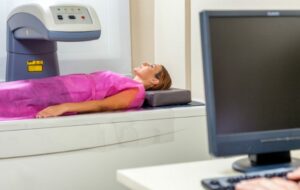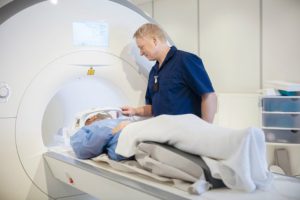Is X-ray Technology Safe?
Probably the number one question heard by our team of radiologists regards our most common scan: the x-ray.

Is X-ray Technology Safe?
Probably the number one question heard by our team of radiologists regards our most common scan: the x-ray. Our patients want to know: “is x-ray technology safe?” The best way to discover an answer to a medical question comes from uncovering further information. The better understanding you have of x-ray technology and its risks, the more prepared and informed you’ll feel when it comes to dealing with x-rays and making decisions regarding your health.
First, let’s take a closer look at x-ray technology itself.
An Intro
The most widely used scan, the x-ray, uses waves of energy (electromagnetic radiation) to create detailed pictures of the interior of a patient’s body. As the x-ray passes through the body, it produces images of the bones, organs, and other internal structures. Typically, x-rays are used to look at broken bones, for dental images, or for a closer look at internal organs, among a variety of other uses. X-rays are a very quick scan, and are completely painless for the patient. As x-rays are comprised of energy, radiation from a scan is absorbed into the body. This amount of radiation, known as a radiation dose, is what causes many patients concern about whether or not x-ray technology poses a threat to their health.
X-ray technology is also utilised in a CT scan. Traditionally, a CT uses a significantly higher radiation dose than plain x-ray, but also provides much more detailed information, which can be paramount in diagnosis. In recent years there has been a reduction in CT dose for a variety of reasons. Smaller areas are imaged when possible and the technology optimises the use of the dose for most effective, low dose results.
Radiation in the World
It may come as a surprise to some, but as we go about our daily lives on this planet, we are constantly exposed to some naturally occurring “background” radiation. Depending on where you live, your radiation exposure may vary. Even an airline flight exposes a passenger to a small amount of radiation.
In comparison to natural exposure, x-ray technology does not bring you in contact with much greater amounts of radiation. Background radiation is equivalent to 4 chest x-rays a year. Some x-rays and CT scans use significantly higher doses of radiation, but even these amounts pose a small risk to a patient.
Many patients may be concerned about the risk of cancer from radiation exposure. According to the UK’s National Health Service, x-ray exposure increases your risk of developing cancer by only one in a million. Though the risk of developing cancer may be small, we continue to focus on patient safety through everything we do at Vision XRAY, and we always utilise the lowest possible radiation dose.
A Focus on Safety
The radiologists at Vision XRAY are committed first and foremost to patient safety, health, and comfort. As a result, when it comes to any technology used, we always seek to minimise risks and perform scans efficiently and effectively. With x-ray, we are wholly focused on using the smallest amount of radiation possible, while still producing effective scan results. Our radiology team always adheres to the recommendations and regulations put forth in the most highly-trusted and scientifically-sound medical research available.
When it is determined that an x-ray or other scan is needed, the benefits and importance of the scan in diagnosis and treatment are the main considerations by your physician and/or radiologist. That the benefits outweigh the potential risks is the primary factor in deciding whether a scan is needed for a patient. In the vast majority of cases, the effectiveness of an x-ray or other scan is significant enough to combat the threat of any potential risks. As a rule, x-ray technology is safe for patients.
In terms of CT scans, which generally use a higher dose than general x-ray, manufacturers have researched and become increasingly aware of dosage. As a result, several different methods of reducing dose in CT scan have been developed by the manufacturers that significantly reduce dose. For example, a certain type of CT which screens for lung cancer makes use of ‘low dose” technique that reduces dose to about 25% of the usual.
Furthermore, we at Vision XRAY, alongside many other leading radiology centres, have developed an “ultra-low dose technique” on some specialised CT scanners we use. This reduces the dose further for specific studies, particularly when following the progress of certain conditions. When working with CT, we always specify the minimum possible radiation dose.
Some Considerations
For children and pregnant women, radiation exposure can be more damaging. Special consideration and attention is taken when it is necessary for a child to receive an x-ray. Radiation doses used will always be minimal. As a pregnant woman, you may be concerned about safety risks for your unborn child. X-rays are generally considered harmless for a developing child, but there may be a small chance of complications developing, particularly early on in pregnancy. You should always inform your radiologist if you believe you may be pregnant. For pregnant women, x-ray technology may be avoided unless absolutely necessary. X-rays of the head or extremities typically do not affect the baby at all, and ultrasound technology, which is used to observe foetal development and health, is a scan which uses absolutely no ionising radiation. In the event that rare circumstances arise in which an x-ray is needed during your pregnancy, your radiologist will take all precautions necessary to ensure your baby is exposed to as little radiation as possible.
The Future
As medical research makes incredible advances in the world of technology, there is more information available than ever before regarding radiation dosage and possible health impacts. At Vision XRAY, we adhere to the most up-to-date, sanctioned guidelines when it comes to x-rays and appropriate radiation dose. As technology moves forward, there is an increased focus on using ultrasound and MRI in diagnosis and treatment. These can be beneficial alternatives to x-ray and CT scan, as neither MRI nor ultrasound use harmful radiation. The future seems to hold the promise of ever better and safer technology, and we at Vision XRAY will continually look for ways to give our patients the very best.
Read our articles and FAQs
We’re delighted to provide updates on the latest medical imaging technology and answer your most frequently asked questions about our services.









